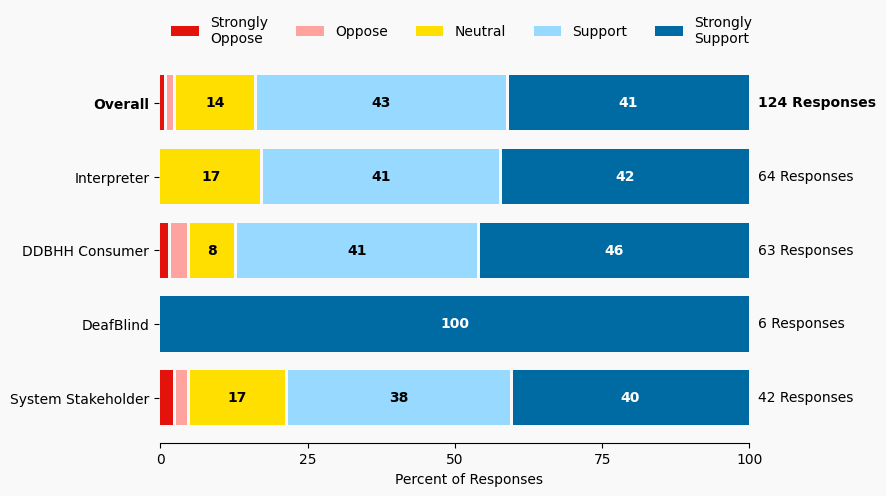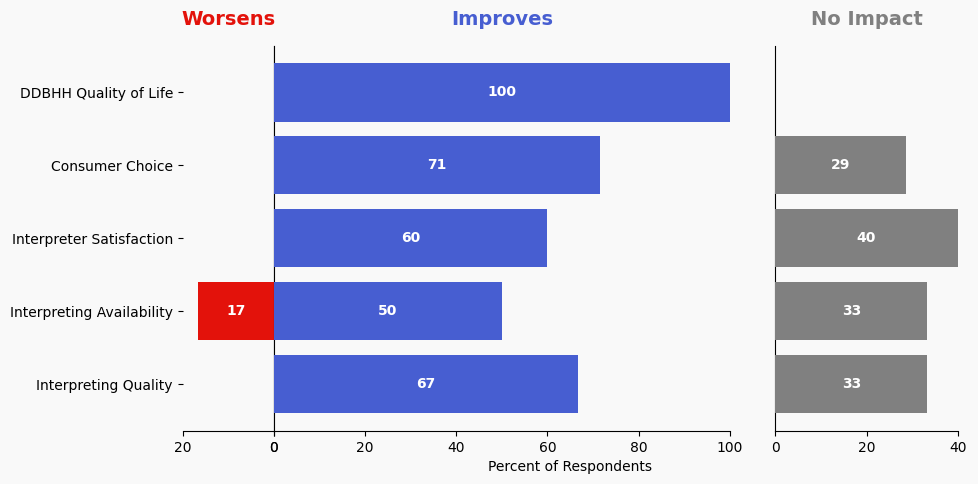49 Conduct a DeafBlind Minnesotans Study
Issue: More information is needed about the quality of life for DeafBlind Minnesotans
Proposed Solution: Commission and SSB contract for an in-depth study on DeafBlind Minnesotans. The study can include demographic information, service needs, service barriers, communication preferences and identifying gaps or barriers for DeafBlind individuals in their daily lives.
Expected outcome: Understanding that there are severe gaps for DeafBlind individuals to experience full participation in many areas of life, having data to show the areas of challenge will support requests for funding and programs needed to create greater equity for DeafBlind individuals.
Who is impacted: DeafBlind consumers, service providers
Timeline: 6 months
Note: Content of this study would overlap with the overall DDBHH study recommended in #11.

Summary of Support Image Description
The stacked bar charts show how respondents rated their level of support and the total number of responses. The percentage for the five support levels is shown from left to right: Strongly Oppose (Dark Red), Oppose (Light Red), Neutral (Yellow), Support (Light Blue), and Strongly Support (Dark Blue).
Respondents may identify with multiple subgroups. The overall level of support is:
Overall
Strongly Oppose: 1%
Oppose: 2%
Neutral: 14%
Support: 43%
Strongly Support: 41%
Click to see the detailed image description for each subgroup.
Interpreter
Strongly Oppose: 0%
Oppose: 0%
Neutral: 17%
Support: 41%
Strongly Support: 42%
DeafBlind
Strongly Oppose: 0%
Oppose: 0%
Neutral: 0%
Support: 0%
Strongly Support: 100%
DDBHH Consumer
Strongly Oppose: 2%
Oppose: 3%
Neutral: 8%
Support: 41%
Strongly Support: 46%
System Stakeholder
Strongly Oppose: 2%
Oppose: 2%
Neutral: 17%
Support: 38%
Strongly Support: 40%
Overview of Respondents Opting for In-Depth Solution Analysis
After indicating their support level, 4% of the 124 respondents opted in to further assess whether the solution would worsen or improve on five metrics. Of the opt-in reviewers (6 respondents), 100% supported the solution, 0% were neutral on the solution, and 0% opposed the solution.
The remaining 118 respondents did not opt in to further assess the solution. Of these people, 83% support the solution, 14% were neutral on the solution, and 2% opposed the solution.
Reviewer Evaluation of Solution Effectiveness

Solution Effectiveness Image Description
The stacked bar charts show how respondents assessed the effectiveness of this solution based on five metrics. For each metric, the percentage of respondents is shown from left to right: Worsens (Red), Improves (Blue), No Impact (Gray).
DDBHH Quality of Life
Makes It Worse 0%
Makes It Better 100%
No Impact 0%
Interpreter Satisfaction
Makes It Worse 0%
Makes It Better 60%
No Impact 40%
Consumer Choice
Makes It Worse 0%
Makes It Better 71%
No Impact 28%
Interpreting Availability
Makes It Worse 16%
Makes It Better 50%
No Impact 33%
Interpreting Quality
Makes It Worse 0%
Makes It Better 66%
No Impact 33%
Reviewer Feedback and Insights
Interpreter
Comments from Interpreters express the importance of including both DeafBlind interpreters and DeafBlind consumers in the study to ensure comprehensive results. One comment indicates the need for careful implementation of this study by offer the study in multiple formats to account for a variety of accessibility needs and preferences.
Deaf, DeafBlind, Hard of Hearing
Comments from DDBHH Consumers broadly agree that such a study is critical and stress the importance of involving a diverse group of DeafBlind individuals in the study to represent the community accurately. One comment emphasizes the need to include DeafBlind children and to include DeafBlind families into the study.
System Stakeholder
Comments from System stakeholders highlight the importance of the study for improving services and emphasize securing funding to support the study effectively. One comment suggests involving more partners, such as the MN DeafBlind Project, DeafBlind Services Minnesota (DBSM), and Helen Keller National Center (HKNC), to broaden the scope of the study since State Services for the Blind (SSB) focuses on employment initiatives.
PREVIOUS SOLUTION
48 Provide ProTactile and Communication Intensive Trainings for DeafBlind Minnesotans
Issue: Many DeafBlind individuals do not always have exposure to ProTactile. Often interpreters have greater access to training than DeafBlind Minnesotans. Some DeafBlind consumers may not always know what communication works best for them if they haven’t had exposure, nor do they have training on how to instruct interpreters to work with them best. Often, interpreters walk into assignments with DeafBlind individuals not knowing what communication works best for them, resulting in frustration and potentially failed communication on both sides.
NEXT SOLUTION
50 Host DeafBlind Convention in MN
Issue: DeafBlind Minnesotans need more information about services and resources available to them; service providers need more information on service gaps.
Leave a Reply